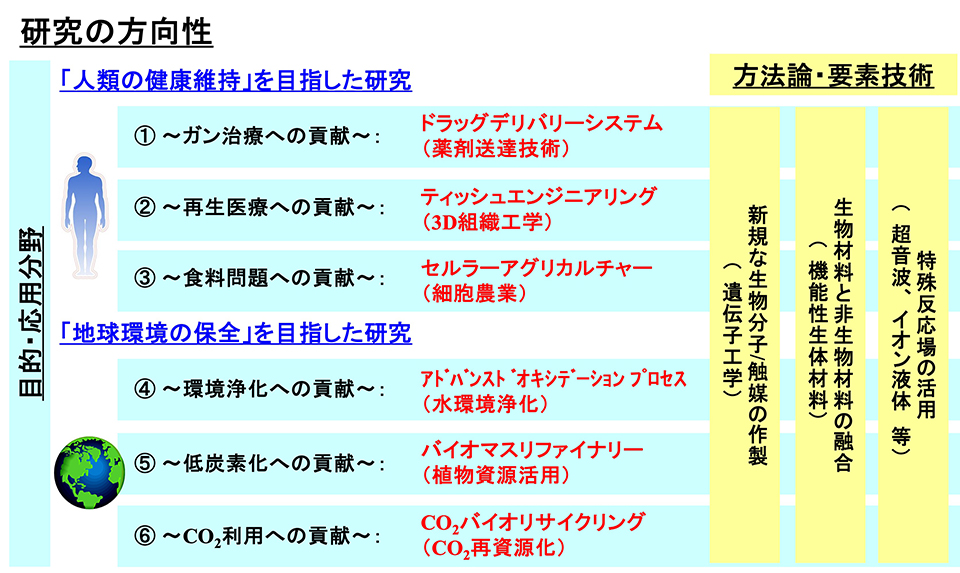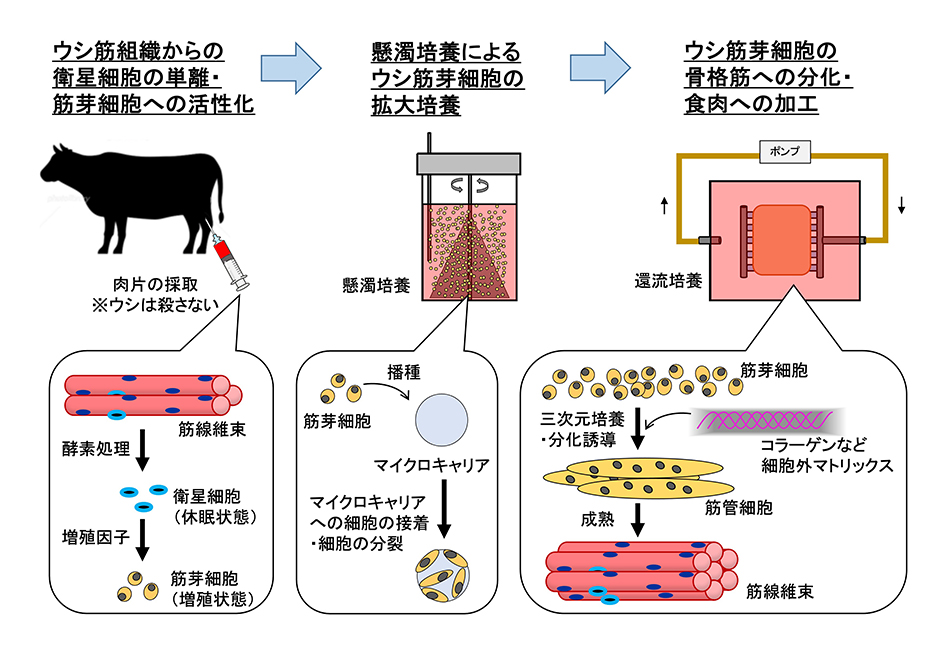金沢大学 理工学域生命理工学類バイオ工学コース 生物化学工学研究室仁宮一章研究室
Biochemical Engineering Laboratory (Ninomiya Laboratory), Kanazawa University
RESEARCH SUBJECT研究内容
Direction of research 研究の方向性
生物化学工学研究室では、生物が有する独自の構造や機能を、原料・触媒・デザインとして工学的に活用し、それにより得られる技術や物質を、環境・医療へ応用することにより「人類の健康維持」や「地球環境の保全」に貢献する“バイオによるモノづくり”に取り組んでいます。
主な基盤技術は、遺伝子組換え手法を応用した新規な生体分子や微生物の開発、さらに核酸やタンパク質などの生体分子と無機材料の融合による新規な機能性材料の開発、そして、超音波やイオン液体などの特殊反応場です。これらの技術を組み合わせることにより、人類の健康維持や地球環境の保全にむけた応用研究を行っています。
人類の健康維持に関しては、①がん治療への貢献としてドラッグデリバリー(薬剤送達技術)、②再生医療への貢献としてテッシュエンジニアリング(3D組織工学)、そして、③食糧問題への貢献としてセルラーアグリカルチャー(細胞農業)の研究を行っています。一方、地球環境の保全に関しては、④環境浄化への貢献としてアドバンスドオキシデーションプロセス(水環境浄化)、⑤低炭素化への貢献としてバイオマスリファイナリー(植物資源活用)、そして、⑥CO2利用への貢献としてCO2バイオリサイクリング(CO2再資源化)の研究を行っています。
The Laboratory of BioChemical Engineering is engaged in “bio-based manufacturing” to contribute to “maintenance of human health” and “conservation of the global environment” by engineering the unique structures and functions of living organisms as raw materials, catalysts, and designs, and applying the resulting technologies and substances to environmental and medical applications.
Our main fundamental technologies are the development of new biomolecules and microorganisms by applying genetic engineering, the development of new functional materials by fusing biomolecules such as nucleic acids and proteins with inorganic materials, and special reaction fields such as ultrasound and ionic liquids.
By combining these technologies, we are conducting applied research for the maintenance of human health and the conservation of the global environment. With regard to the maintenance of human health, we are conducting research on (1) drug delivery system as a contribution to cancer therapy, (2) 3D tissue engineering as a contribution to regenerative medicine, and (3) cellular agriculture as a contribution to food problem. On the other hand, with regard to global environmental conservation, we are conducting research on (4) advanced oxidation processes as a contribution to water environmental purification, (5) plant biomass refineries as a contribution to low-carbon society, and (6) CO2 bio-recycling as a contribution to CO2 utilization.
Research for maintenance of human health 「人類の健康維持」を目指した研究
① Drug delivery system for cancer therapy ~ガン治療への貢献~:ドラッグデリバリーシステム(薬剤送達技術)
Biomolecules such as proteins and nucleic acids that specifically recognize cancer cells are produced, and are bound to the surface of nanocarriers encapsulating anticancer drugs, so as to deliver drugs to the tumor site in a specific and sufficient concentration (drug targeting). After accumulation in the cancerous tissue, the drug release from the nanocarrier is artificially controlled by ultrasound irradiation from outside the body, and OH radicals are also generated (drug release control) to eradicates cancer.
② 3D tissue engineering for biomedical use ~再生医療への貢献~:テッシュエンジニアリング(3D組織工学)
We will create 3D tissues with designable internal structures by using the “Kenzan method”, which involves i) creating spheroids of 500 μm in diameter with various cell types, cell number ratios, and spatial arrangements, and then, ii) using a micromanipulator to place the different types of spheroids at arbitrary positions on a Kenzan. We will also attempt to create larger 3D tissues by using the created 3D tissues themselves as building blocks. By integrating the above, we will develop a technology to construct cm-sized designable 3D tissues at high speed.
③ Cellular agriculture for cultured meat production ~食糧問題への貢献~:セルラーアグリカルチャー(細胞農業)
We will develop basic technology for the production of three-dimensional tissues composed of cells that are intended as food (cultured meat). First, we will prepare a basic culture medium derived from inedible photosynthetic microorganisms. Then, we will produce three-dimensional muscle tissue without using animal-derived serum or scaffold proteins. In this way, we will establish a technology for the inexpensive production of three-dimensional fibrous muscle tissue as cultured meat without the need for animal-derived serum or animal-derived scaffolding proteins, using inedible photosynthetic microorganisms that grow by fixing CO2 as a raw material.
Research for sustainability of global environment 「地球環境の保全」を目指した研究
④ Advanced oxidation process for water environment purification ~環境浄化への貢献~:アドバンスド オキシデーション プロセス(水環境浄化)
It is known that ultrasound irradiation of water generates reactive oxygen species and shock waves. We have found that the addition of heterogeneous catalysts such as titanium dioxide particles or homogeneous catalysts such as Fenton’s reagent could increase the effects of reactive oxygen species and shock waves generated by ultrasound irradiation, and applied to the decomposition of toxic chemicals and sterilization of harmful microorganisms. Compared with conventional photocatalytic reactions, this technology has many advantages such as a large ultrasonic penetration distance into the aqueous phase, which can be developed into a revolutionary new technology.
⑤ Plant biomass refinery for carbon neutrality ~低炭素化への貢献~:バイオマスリファイナリー(植物資源活用)
We will develop technology to efficiently produce fuels and chemical raw materials from inedible lignocellulosic biomass. In particular, by treating woody biomass with ionic liquids, cellulose (a plant cell wall component that shows a strong chemical and physical structure) and lignin (a polymer of aromatic compounds) can be pretreated at room temperature and pressure. This allows the subsequent biological reaction, chemical reaction, and molding process to proceed efficiently, resulting that the lignocellulosic material can be efficiently converted into biofuel, bio-resin, and biocomposites.
⑥ CO2 bio-recycling for CO2 utilization ~CO2利用への貢献~:CO2バイオリサイクリング(CO2再資源化)
Aiming at the recycling of fossil resource-derived CO2, we will develop technology for the continuous and rapid conversion of CO2 into chemical raw materials (ethanol and isopropanol) by microbial electrosynthesis. This will enable the direct recycling of CO2-containing exhaust gas from thermal power plants and plastic waste incineration plants into ethanol and isopropanol using solar- and wind-derived electricity. This research will be a challenging study toward the reduction of CO2 emissions through CO2 bio-recycling.







